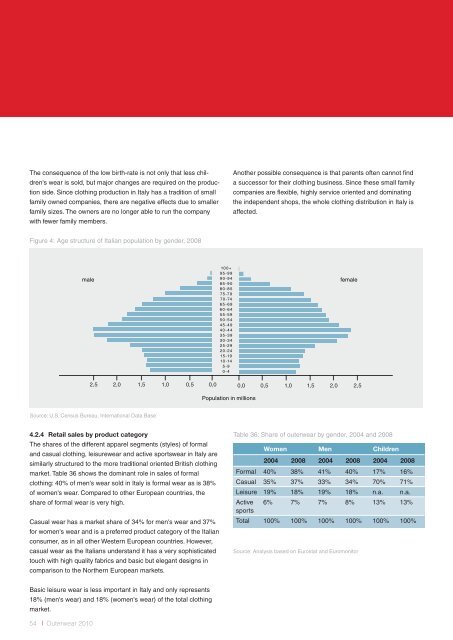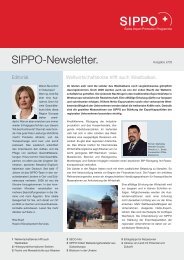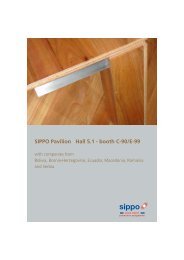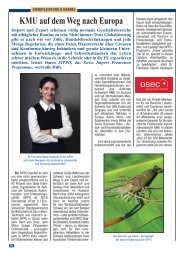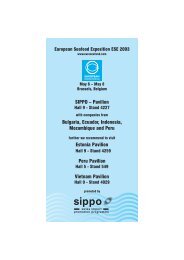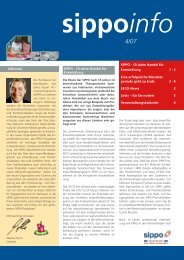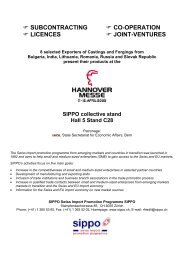Outerwear. - Business Location Switzerland
Outerwear. - Business Location Switzerland
Outerwear. - Business Location Switzerland
You also want an ePaper? Increase the reach of your titles
YUMPU automatically turns print PDFs into web optimized ePapers that Google loves.
The consequence of the low birth-rate is not only that less children's<br />
wear is sold, but major changes are required on the production<br />
side. Since clothing production in Italy has a tradition of small<br />
family owned companies, there are negative effects due to smaller<br />
family sizes. The owners are no longer able to run the company<br />
with fewer family members.<br />
Figure 4: Age structure of Italian population by gender, 2008<br />
Source: U.S. Census Bureau, International Data Base<br />
54<br />
l <strong>Outerwear</strong> 2010<br />
10 0 +<br />
9 5 - 9 9<br />
9 0 - 9 4<br />
8 5 - 9 0<br />
8 0 - 8 5<br />
75 -79<br />
70 -74<br />
6 5 - 6 9<br />
6 0 - 6 4<br />
5 5 - 59<br />
50 - 5 4<br />
4 5 - 49<br />
4 0 - 4 4<br />
3 5 - 3 9<br />
3 0 - 3 4<br />
25 -29<br />
20 -24<br />
15 -19<br />
10 -14<br />
5 - 9<br />
0 - 4<br />
Population in millions<br />
Another possible consequence is that parents often cannot find<br />
a successor for their clothing business. Since these small family<br />
companies are flexible, highly service oriented and dominating<br />
the independent shops, the whole clothing distribution in Italy is<br />
affected.<br />
male female<br />
2,5 2,0 1,5 1,0 0,5 0,0 0,0 0,5 1,0 1,5 2,0 2,5<br />
4.2.4 Retail sales by product category<br />
The shares of the different apparel segments (styles) of formal<br />
and casual clothing, leisurewear and active sportswear in Italy are<br />
similarly structured to the more traditional oriented British clothing<br />
market. Table 36 shows the dominant role in sales of formal<br />
clothing: 40% of men's wear sold in Italy is formal wear as is 38%<br />
of women's wear. Compared to other European countries, the<br />
share of formal wear is very high.<br />
Casual wear has a market share of 34% for men's wear and 37%<br />
for women's wear and is a preferred product category of the Italian<br />
consumer, as in all other Western European countries. However,<br />
casual wear as the Italians understand it has a very sophisticated<br />
touch with high quality fabrics and basic but elegant designs in<br />
comparison to the Northern European markets.<br />
Basic leisure wear is less important in Italy and only represents<br />
18% (men's wear) and 18% (women's wear) of the total clothing<br />
market.<br />
Table 36: Share of outerwear by gender, 2004 and 2008<br />
Women Men Children<br />
2004 2008 2004 2008 2004 2008<br />
Formal 40% 38% 41% 40% 17% 16%<br />
Casual 35% 37% 33% 34% 70% 71%<br />
Leisure 19% 18% 19% 18% n.a. n.a.<br />
Active<br />
sports<br />
6% 7% 7% 8% 13% 13%<br />
Total 100% 100% 100% 100% 100% 100%<br />
Source: Analysis based on Eurostat and Euromonitor


